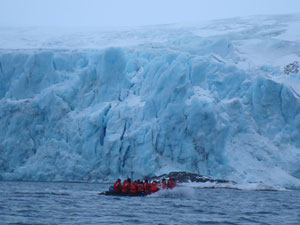

 | |||||||||||
|
|
Journals 2008/2009Roy Arezzo
August 5, 2008 After the last of the scientists left town, I stuck around Punta Arenas to finish up some work and travel around southern Chile. I met with a friend from New York Harbor School and we traveled to Port Natales for an epic six-day backpacking trek through Torres Del Paine to get a taste of Patagonia. We covered over 88 kilometers through snow, ice, and rocky terrain and were rewarded with incredible images and memories. Our excursion also served as a great opportunity to discuss the FOODBANCS work, fresh from Antarctica, with someone from home in preparation for sharing my experiences with my students. The Antarctic Peninsula is a region of majestic beauty. Sea ice is a marvel to witness and important to the polar ecosystems. Unfortunately, it is this sea ice that is diminishing as warming at our poles increases. When I returned to the States I found some alarming articles on climate change and Associated Press reports of about sea ice reductions in the Arctic Sea waiting for me at home (http://news.yahoo.com/s/ap/20080827/ap_on_sc/sci_arctic_ice). The results of the FOODBANCS projects along the Antarctic Peninsula will serve as important baseline data in bentho-pelagic coupling to compliment long-term pelagic and euphotic zone research conducted as part of the Antarctic Program (Palmer Station LTER and GLOBEC Programs). Having had time to reflect and read papers that I probably should have digested before the project, I realized there are a few unanswered questions that warrant more explanation in my journals. What is a "Food Bank"? How does the benthos serve as a lens to study climate change? What will we learn from FOODBANDS2? Thorium-234 is a naturally occurring radioisotope that is regularly created from the radioactive decay uranium salts in seawater. Thorium-234 can serve as an indictor of the "freshness" of organic material. When thorium-234 is formed, it readily bonds to available organic particles passing through the water column. Thorium-234 has a short 24-day half life, meaning that any bottom sediments containing extra thorium-234 atoms absorbed in the water column have been recently added to the sediment food bank. Carbon-14 data will tell us the origin of older materials. Data from sediment traps, water samples, seafloor sediments at various depths, and sediment from the tissue/guts of deposit feeders will be analyzed to give a fuller picture of community nutrient cycling. This information will be correlated with biodiversity and biomass data from microbes to megafauna to provide us with a complete picture of seasonal and annual fluctuations in carbon and nitrogen cycling, the key ingredients of life, along a latitudinal sea-ice gradient. Although I am sad to see my summer come to an end, I look forward to remaining connected to the FOODBANCS project as the story unfolds and new information becomes available. I once again would like to express my gratitude for this opportunity and wonderful experience to The ARMADA Project, the National Science Foundation, Craig Smith, David DeMaster, and all the scientists and crew of the NATHANIEL B. PALMER, University of Hawaii, North Carolina State University, and University of San Paulo, Brazil.
|
||||||||||

